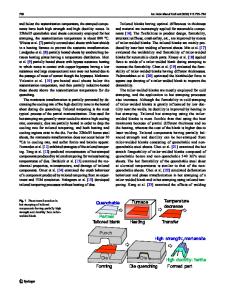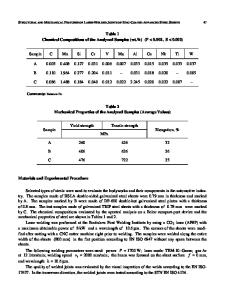Formability Analysis of Diode-Laser-Welded Tailored Blanks of Advanced High-Strength Steel Sheets
- PDF / 934,838 Bytes
- 13 Pages / 593.972 x 792 pts Page_size
- 52 Downloads / 357 Views
ON
A. Advanced High-Strength Steel Sheets Recently, there has been significant improvement in the versatility of formable steel grades for automotive stampings. Automotive steels can generally be categorized into three classes: lower-strength steels (mild, interstitial-free, and extra-deep drawing-quality steels); high-strength steels (HSSs) (high-strength low-alloy (HSLA), carbon-manganese, bake-hardening, and high-strength interstitial-free steels); and advanced HSSs (AHSSs) (dual-phase (DP), transformation-induced plasticity, complex-phase, and martensitic steels). The principal differences between HSSs and AHSSs are related to their microstructure and strengthening mechanisms. The HSS steels, which are mainly ferritic, are strengthened by grain refinement and by precipitation hardening, which is achieved by microalloying additions. The AHSSs are multiphase steels that are manufactured with an intercritical annealing step designed to produce a ferrite and austenite bimodal microstructure, which, upon cooling, results in a ferritic matrix with dispersed decomposition products such as martensite
S.K. PANDA, Postdoctoral Fellow, Department of Mechanical Engineering, and V.H. BALTAZAR HERNANDEZ, Doctoral Student, M.L. KUNTZ, Research Professor, and Y. ZHOU, Professor, Centre for Advanced Materials Joining, are with the University of Waterloo, Waterloo, ON, Canada. Contact e-mail: [email protected]; [email protected] Manuscript submitted November 14, 2008. Article published online June 16, 2009 METALLURGICAL AND MATERIALS TRANSACTIONS A
and bainite and, in some cases, retained austenite. The AHSSs exhibit yield strengths (YSs) similar to the HSSs; however, during deformation, they exhibit persistent strain hardening, which results in higher ultimate strengths with good ductility.[1] Thus, AHSSs have superior combinations of strength and formability, while being reasonably simple and inexpensive to manufacture. These characteristics are desirable for weight reduction, structural improvement, and reduction in the costs of structural automotive components. B. Tailored-Welded Blanks and Challenges Tailor-welded blanks (TWBs) are fabricated by welding multiple sheets of different shapes, grades, and thicknesses together in a single plane, after which the weldment is then stamped into a three-dimensional shape.[2,3] The concept of combining different steel grades into a single welded blank enables manufacturing engineers to ‘‘tailor’’ the blank such that various steel properties are optimized within the part. For example, TWBs give the designer the flexibility to eliminate reinforcements while improving the structural and dimensional characteristics by putting a higher-strength material at high-stress locations.[4] The forming behavior of a TWB, however, will be influenced by many factors, such as: material property changes in the fusion zone (FZ) and heat-affected zone (HAZ) of the weld;[5–9] the effects of the weld on the strain distribution, failure site, and crack propagation;[4,8,10] and nonuniform deforma
Data Loading...











